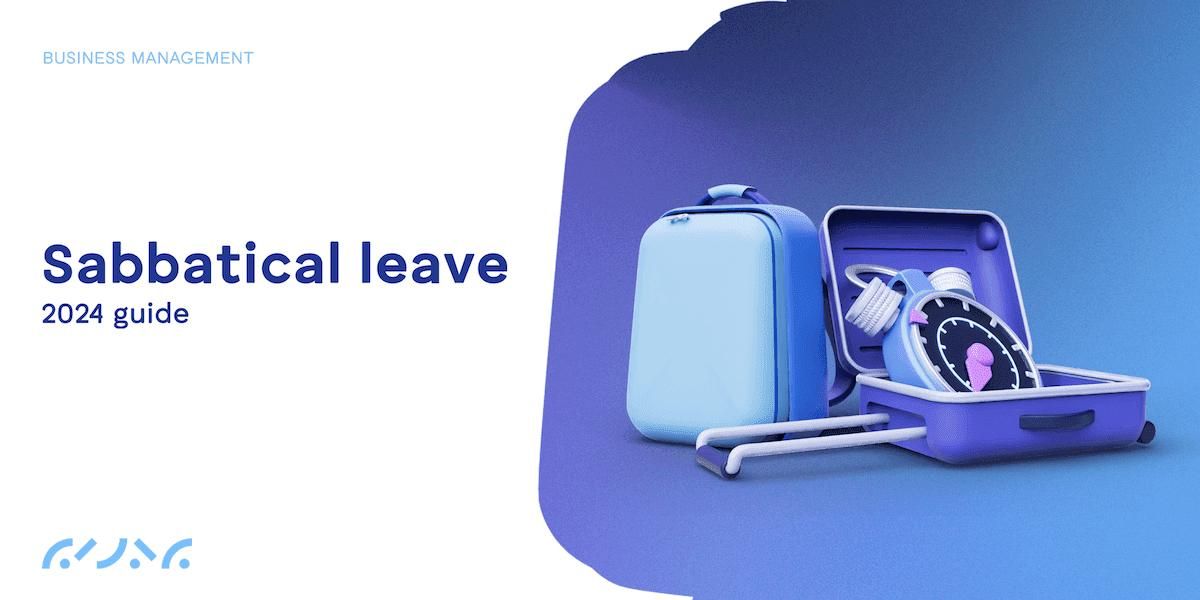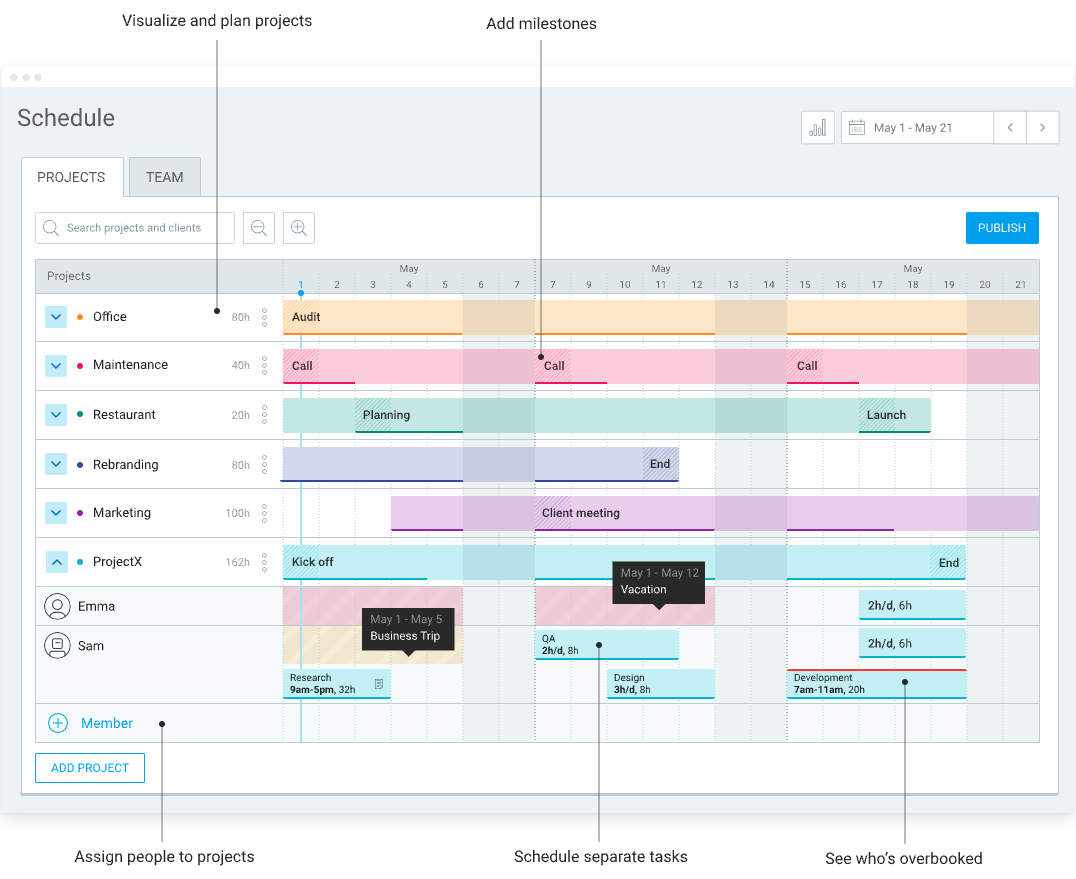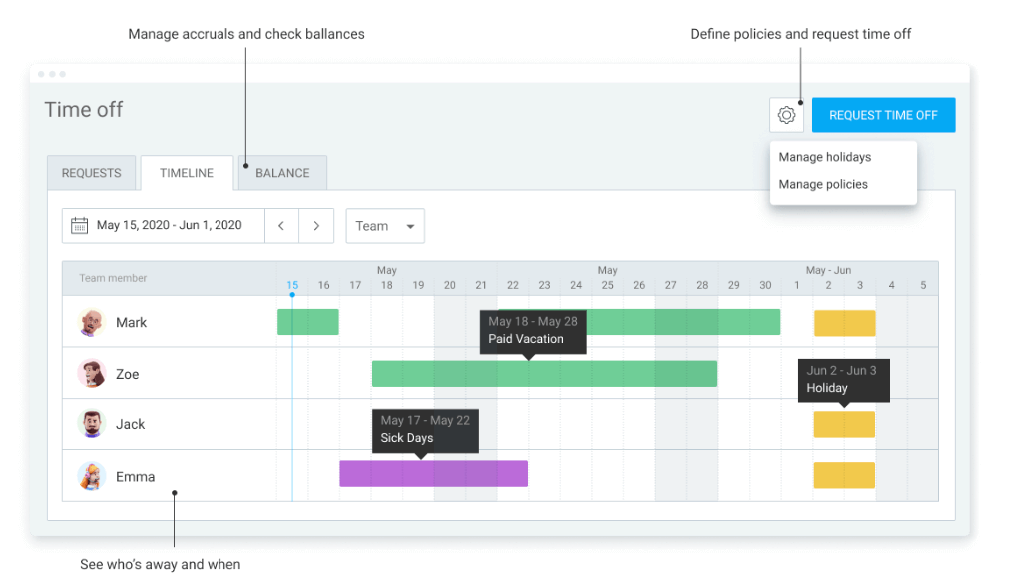People who are fully committed to their jobs and try to be the most efficient in what they do every single day are likely to get tired after a while. That’s why a certain number of companies offer sabbatical leave — a particular kind of time off, granted to employees after they’ve been with a company for an extended period.
If you aren’t familiar with this type of leave, you may have a great deal of questions about it.
That’s why, in this guide, we’ll go through:
- The definition of sabbatical leave,
- Different types of such leave,
- A typical sabbatical leave policy,
- Benefits and drawbacks of sabbatical, and
- Frequently asked questions about this type of leave.
Let’s begin.

- Sabbatical leave is a break from work certain organizations grant their loyal employees after a certain employment duration.
- The company determines the length of sabbatical leaves — they can range from a couple of weeks to a whole year.
- Sabbatical leave can be paid, unpaid, or partially paid.
- Both companies and employees benefit from sabbatical leave — from witnessing higher motivation and productivity levels, and increased job satisfaction, to stronger employee retention with minimized turnover.
- In case the details of the sabbatical leave policy are not worked out properly, there could be some disadvantages, such as issues with additional administrative tasks and workload, or potential cost concerns.
What is sabbatical leave?
Sabbatical leave is a break from work that employees typically use for their personal or professional development.
Although originally available for those working in educational institutions, in recent times, sabbatical leave has become more common in companies from various public and private sectors, too.
In the US, sabbatical leave is not a statutory benefit, but an extended time off that companies decide to offer at their own discretion.
How does a sabbatical leave work?
Not all companies offer sabbatical leave, so the exact details regarding this type of leave may differ depending on a company’s policy.
Typically, employees submit the sabbatical leave request where they state the purpose and length of this break from work. If the request gets approved, employees can further plan and execute their sabbatical. Sometimes, it might be necessary to make certain modifications to the proposal, as suggested by the company.
The companies decide the rules and regulations of their sabbatical leave policy. Eligibility for this leave is usually tied with the years of service and performance during that time. For instance, it’s not uncommon to see that the eligibility criterion is a 5-year tenure (or more).
The typical length of this work break is 1 month but the organization will decide if it’s possible to take even longer leaves. Companies that wish to support employee’s professional development may allow sabbaticals that last for a couple of months to a whole year.
Employers may require detailed reports of sabbatical requests. This is especially true when it comes to remuneration. Some organizations simply state whether the leave is paid or unpaid, while others make a decision based on the nature of the sabbatical.
Employees have to return to work on the agreed date. If the purpose of this time off was to gain skills and improve professionally, employees are often expected to suggest ways to integrate this new knowledge into their work.
🎓 Clockify Pro Tip
Get insight on the best ways to request and monitor time off:
Is sabbatical leave paid or unpaid?
Whether sabbatical leave is paid or unpaid usually depends on a company’s policy.
Typically, companies that offer paid sabbatical leave grant it only after an employee has worked for them for a specific amount of time. Businesses decide what that amount of time will be for their organization. In most cases, paid sabbatical leave is used for professional development purposes, such as pursuing a degree or earning a certificate.
Unpaid sabbatical leave, on the other hand, is most commonly offered when employees want to take a shorter period off work for personal growth.
Sometimes, companies allow their employees to take a partially paid sabbatical leave. This way, they can pursue their interests while the company supports them by paying a portion of their regular salary.
In the end, it’s important to keep in mind that many different factors affect whether the sabbatical will be paid or unpaid.
🎓 Clockify Pro Tip
Interested in getting more information on paid holidays and what they mean for your business? Learn all about it here:
How long is a sabbatical leave?
In general, sabbatical leave can last anywhere from one month to a whole year. It all depends on what the employee wants to do during this time, the purpose of the sabbatical, and the agreement they reach with their company.
For instance, a company might agree to grant a 6-month sabbatical leave to an employee who wishes to pursue higher education or a professional degree or a 1-month sabbatical leave to an employee who simply needs some time for themselves and their well-being.
A typical sabbatical leave policy explained
Every company can decide on its own sabbatical leave rules and terms. Still, every such leave policy should include the following information:
- Eligibility criteria: specifics on which employees qualify for the sabbatical leave.
- Duration: the number of days available for the sabbatical and the admissible frequency of requesting this leave.
- Purpose: acceptable reasons for requesting the sabbatical, such as personal growth, volunteering, and professional development.
- Remuneration: clear explanation of whether the sabbatical leave is paid, unpaid, or partially paid, or whether certain factors may affect this decision, such as the purpose of leave.
- Procedure: detailed guide on how to apply for the sabbatical leave, with further explanation on factors that affect the request approval.
What are the benefits of a sabbatical?
Sabbatical leave comes with a wide range of benefits for employees and employers. Let’s examine some of them in more detail.
Helps boost energy and motivation
When they’re granted a sabbatical leave, employees can use this free time to recharge their batteries and rest. Enjoying a break from an everyday work routine and potential accumulated stress can lead to the much-needed rest, allowing employees to stay motivated with higher energy levels.
🎓 Clockify Pro Tip
Companies should recognize the dangers of career burnout. This can affect employee health as well as work performance and satisfaction:
Workers’ compensation attorney and assistant public defender Luke Smith believes that attorneys find it difficult to take vacations and sabbatical leave:

“There is often a perception amongst attorneys (and likely other professionals) that they cannot task out work or take a vacation. They believe that if they are not constantly monitoring their caseloads, things will go wrong, or they will lose clients. This belief contributes to high-stress levels and diminishes the quality of life outside of work.”
Smith explains that the integration of sabbatical leave policy can benefit the entire organizational aptitude of the company, when devised in advance:

“A sabbatical leave policy demonstrates to employees that they can take a break. It is also an advantage to the business in that it decreases the extent to which the business is a ‘key man operation,’ by having a defined process for the business to cover the workload of an absent employee.”
🎓 Clockify Pro Tip
Want to learn more about productivity issues caused by frequent absence from work? Here’s everything you need to know:
Offers an opportunity for learning new things
It’s not uncommon for employees to take a sabbatical leave to further develop their professional skills. They can use this time off to attend classes and workshops or pursue other educational achievements. The newly acquired skills and knowledge can all be integrated into their job after the sabbatical.
Helps improve job satisfaction and productivity
When their hard work and loyalty are rewarded with a sabbatical leave, employees tend to feel more satisfied with their jobs. A chance to pursue interests or recharge triggers an increase in productivity.
As an expert who had the chance to work in a company that offered sabbatical leave to its employees, Smith noticed the positive effects that this type of leave had on those who took it:

“A law firm that I used to work at implemented a sabbatical leave policy while I was working as an attorney there. I participated in covering work for attorneys who were on sabbaticals. My observation was that employees came back from sabbaticals feeling relieved and grateful. After returning, their comfort level with relying on others for help was greatly increased.”
Helps increase employee loyalty
A sabbatical leave is a direct way for a company to express just how valuable they find their employees. This increases motivation and job satisfaction, strengthening employee loyalty and retention.
Employees who are 100% satisfied with their job are considerably less likely to leave an organization where they feel valued and important. With reduced employee turnover, sabbatical leave creates a win-win situation for both the company and the employees.
🎓 Clockify Pro Tip
Due to stress, burnout, and poor project management, people all over the world are experiencing a decrease in employee loyalty and embracing quiet quitting. However, it’s possible to prevent this — find out how:
What are the disadvantages of a sabbatical?
Both the company and the employee have to take the planning and execution of a sabbatical leave seriously — otherwise, the many benefits may fail to show. In fact, the following downfalls may occur.
Potential cost and administrative issues
If the company doesn’t handle the intricacies of the sabbatical leave policy properly, there’s a risk of potential administrative issues and cost concerns. Poor or untimely distribution of extra work can negatively affect work performance. Also, hiring new staff can create more expenses for the company.
Tip on how to lessen the disadvantage: Essentially, the organization has to handle all the details and prepare for sabbaticals before enforcing the policy so that the management knows exactly how to go about work distribution, new hires, training schedules, etc.
Reintegration difficulties after the sabbatical
It may take a while for the employee to get used to work again. Having a bunch of tasks reassigned at once can still cause stress and a drop in productivity, even after being able to take a leave. Longer absence from work can lead to feelings of isolation, confusion, and imposter syndrome once it’s time to resume.
Tip on how to lessen the disadvantage: To prevent problems with reintegration after the sabbatical, companies should prepare all the necessary updates, training, and available HR strategies to ease employee’s return to work. That way, the risk of wasting too much time for the employee to adjust again will be minimal.
Problems managing the workload during the employee’s absence
Dealing with additional workload can put pressure on other team members and lower their productivity. Also, a lack of proper task descriptions may cause work delays and more stress for everyone involved.
Tip on how to lessen the disadvantage: If a sabbatical leave is a viable option for the company’s staff, it’s essential to plan workload distribution in advance. Equal allocation of duties and proper training for replacement hires will help prevent burnout and overworking.
Potential financial difficulties
In case the sabbatical leave is unpaid or partially paid, employees might have to deal with monetary issues during their work break. Losing financial support can easily diminish the efficiency and benefits of the sabbatical.
Tip on how to lessen the disadvantage: It’s paramount that companies have clearly defined remuneration policy so that the employees can adequately prepare before taking time off.
Ideas and examples for sabbatical leave
What is a sabbatical leave if not an incentive for loyal professionals to give their top performance while enjoying the benefits of a well-deserved break? The following companies have worked out a system for incorporating such a leave policy that keeps everyone happy:
- Intel offers paid sabbatical leave to its eligible employees — a 4-week time off after 4 years of service or an 8-week break from work after 7 years of service.
- PayPal offers paid 4-week leave to its full-time and part-time employees after 5 years of employment with the company.
- Adobe grants its employees paid sabbatical leave — 4 weeks after 5 years of employment, 5 weeks after 10 years of employment, and 6 weeks after 15 years with the company.
FAQs about sabbatical leave
Do you need more information about sabbatical leave? In this section we will explain the differences between sabbatical leave and some other types of leave, and clear away any remaining confusion.
What is the difference between sabbatical and vacation?
Employees get to use their vacation rights however they see fit for 2-3 weeks every year, while sabbatical leave is supposed to last longer than vacation and is used for personal/professional development every couple of years or so.
What is the difference between sabbatical and career break?
A career break refers to a break from working when a person quits their job, unlike the sabbatical where one is still employed and will resume their position at the company after the break.
What is the difference between sabbatical and PTO?
PTO refers to all sorts of paid time off — including vacation and sick leave — and not just one specific type of paid leave. As such, sabbaticals may fall under this category — if the company policy mandates they be paid.
🎓 Clockify Pro Tip
We have many different PTO templates that you can adjust and use for your business needs:
What is the difference between sabbatical and leave of absence?
Leave of absence is an FMLA-regulated leave that employees get to use for medical emergencies, unlike sabbaticals which are company-specific and used for professional or personal betterment. Leave of absence is almost always unpaid, while sabbatical leave can be paid if the employer decides to offer that benefit.
Who gets to take a sabbatical at a company?
When companies offer a sabbatical leave, they usually do it as a form of reward for their loyal employees. It’s not uncommon to see sabbaticals offered to workers after 5 or even 10 years of employment, especially in education, medical, tech, and finance sectors. In the end, it all depends on what aligns with the company’s needs and values.
For instance, university professors at NYU become eligible to take this type of leave for the first time only after 6 consecutive years of full-time service as full-time members of the faculty at New York University.
How can you prepare for an employee’s sabbatical leave?
Managing the workload of the employee who’s taking a sabbatical leave is the primary concern for the upper and middle management. Many companies deal with this by allocating responsibilities equally to their existing staff or employing temporary workers/contractors to take over the workload for the time being.
It’s crucial to carefully plan for the sabbatical leave, including efficient communication, both company and employee expectations, and transitioning back to work after the leave is over.
This is where tools like Clockify can help you. Clockify is a time tracking app that lets you stay on top of all of your projects and hours spent on them.
Thanks to Clockify’s scheduling feature, organizations can easily allocate different tasks and projects to team members, keep track of everything, and even see who’s overbooked.

Clockify can also help you keep a record of sabbatical leave.
Use Clockify to manage and track sabbatical leave
Clockify allows you to constantly monitor time off requests and manage employee leaves. You can also set different time off policies, such as those for holidays, vacations, sick leave — and sabbaticals.
Once you introduce the sabbatical leave policy and add the option to request this type of time off, people will be able to request sabbaticals whenever necessary — you’ll be able to track when they’ll be away on the Timeline, and make future plans and schedules accordingly.


If necessary, you can export all time off requests and balances in Excel and CSV, for further analysis.
So, to manage employee attendance and leave, and create an efficient work environment, consider trying out our time tracking software.
How we reviewed this post: Our writers & editors monitor the posts and update them when new information becomes available, to keep them fresh and relevant.

